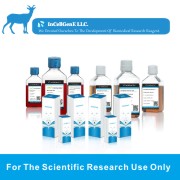

Overview
| Organism | Homo sapiens, human |
|---|---|
| Tissue | kidney, cortex/proximal tubule |
| Cell Type | human papillomavirus 16 (HPV-16) transformed |
| Product Format | frozen |
| Morphology | epithelial |
| Culture Properties | adherent |
| Biosafety Level |
2 [Cells contain Papilloma viral DNA sequences]
Biosafety classification is based on U.S. Public Health Service Guidelines, it is the responsibility of the customer to ensure that their facilities comply with biosafety regulations for their own country. |
| Disease | Papilloma |
| Age | adult |
| Gender | male |
| Storage Conditions | liquid nitrogen vapor phase |
Properties
| Derivation |
HK-2 (human kidney 2) is a proximal tubular cell (PTC) line derived from normal kidney.
The cells were immortalized by transduction with human papilloma virus 16 (HPV-16) E6/E7 genes.
The cell line appears to be derived from a single cell based on Southern and FISH analysis.
|
|---|---|
| Clinical Data |
adult
male
|
| Receptor Expression |
epidermal growth factor (EGF), expressed
|
| Genes Expressed |
alkaline phosphatase; gamma glutamyltranspeptidase; leucine aminopeptidase; acid phosphatase; cytokeratin; alpha 3, beta 1 integrin; fibronectin
|
| Cellular Products |
alkaline phosphatase; gamma glutamyltranspeptidase; leucine aminopeptidase; acid phosphatase; cytokeratin; alpha 3, beta 1 integrin; fibronectin
|
| Comments |
The recombinant retrovirus vector pLXSN 16 E6/E7 containing the HPV-16 E6/E7 genes was used to transfect the ectotropic packaging cell line Psi-2.
Virus produced by the Psi-2 cells was used to infect the amphotropic packaging cell line PA317 (seeATCC CRL-9078).
Virus produced by the PA317 cells was used to transduce primary PTCs.
Although pLXSN 16 E6/E7 also confers resistance to neomycin, selection in G418 was not used to isolate transduced clones.
The cell line appears to be derived from a single cell based on Southern and FISH analysis.
The E6/E7 genes are present in the HK-2 genome as determined by PCR.
The cells retain a phenotype indicative of well differentiated PTCs.
They are positive for alkaline phosphatase, gamma glutamyltranspeptidase, leucine aminopeptidase, acid phosphatase, cytokeratin, alpha 3,beta 1 integrin, and fibronectin.
The cells are negative for factor VIII related antigen, 6.19 antigen and CALLA endopeptidase.
HK-2 cells retain functional characteristics of proximal tubular epithelium such as Na+ dependent / phlorizin sensitive sugar transport and adenylate cyclase responsiveness to parathyroid, but not to antidiuretic hormone.
The cells are capable of gluconeogenesis as evidenced by their ability to make and store glycogen.
HK-2 cells are anchorage dependent.
The cells will not grow in methylcellulose, soft agar or suspension.
HK-2 cells can reproduce experimental results obtained with freshly isolated PTCs.
|
Background
| Complete Growth Medium |
The base medium for this cell line is provided by Invitrogen (GIBCO) as part of a kit: Keratinocyte Serum Free Medium (K-SFM), Kit Catalog Number 17005-042. This kit is supplied with each of the two additives required to grow this cell line (bovine pituitary extract (BPE) and human recombinant epidermal growth factor (EGF). To make the complete growth medium, you will need to add the following components to the base medium:
|
|---|---|
| Subculturing |
Volumes are given for a 75 cm2 flask. Increase or decrease the amount of dissociation medium needed proportionally for culture vessels of other sizes. Corning® T-75 flasks (catalog #430641) are recommended for subculturing this product.
Note: The cells should not be allowed to become confluent, subculture at 80% of confluence.
Subcultivation Ratio: A subcultivation ratio of 1:4 is recommended
Medium Renewal: Every 2 to 3 days
|
| Cryopreservation |
Freeze medium: Complete growth medium supplemented with 7.5% (v/v) DMSO
Storage temperature: liquid nitrogen vapor phase
|
| Culture Conditions |
Atmosphere: air, 95%; carbon dioxide (CO2), 5%
Temperature: 37��C
Growth Conditions: Cell growth is dependent on epidermal growth factor. The cells should not be allowed to become confluent. Subculture at 80% of confluence.
|


